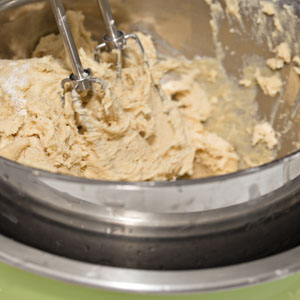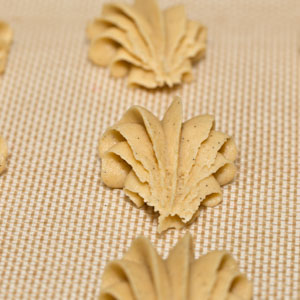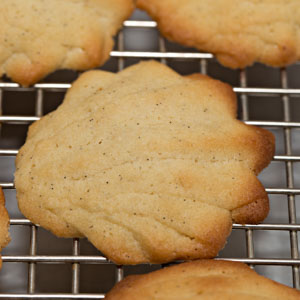Spritzgebäck (Piped Butter Cookies)
introduction
An achingly tender butter cookie with a touch of snap, Sprtizgebäck join other more moody and exotic specimens on the German holiday platter. Their formula comprises a sweet pastry dough moistened with enough egg to coax (i.e., shovel) it into the tight girdle of a pastry bag and be piped (spritzed) into pretty shapes. Oh, and did I mention vanilla? Nothing smells more ethereal than a tin of Spritzgebäck with a just-lifted lid. The alchemy at play when butter—whose flavor compounds perform at a sub-perceptible threshold if raw—interacts with flour and sugar in the oven is prodigious. Everything browns and crisps in consort and begets a haunting caramel-like fragrance and a deep, rich taste. (The vanilla uses the entire occasion for flagrant self-promotion.) Don’t believe for a moment that a heightened sensory experience like the one we just described occurs to this extent with flour that has been roller-milled, scalped of germ to render it shelf stable, bleached (in some cases), and lined up on a supermarket shelf.
On the other hand . . .
Anson Mills pastry flour underperformed at the task of producing the Spritzgebäck’s crisply piped contours. The cookies’ flavor and texture were extraordinary, but our pre-industrial wheat varieties bring less raw strength to a rich cookie environment than contemporary wheat flour. We auditioned a couple of other Anson Mills flours, and truthfully, none of them persuaded the cookie dough to stay in form quite as well as their grocery-store foes. We selected French Mediterranean Bread Flour from its audition tape: its flavor surpasses even our pastry flour in this formula and it is just enough stronger to vouchsafe the cookies’ pretty form. Had we reduced hydration, the cookies might have gained a more starched appearance, but they would had to have been formed with a cookie press—a look too industrial for our taste. Their texture would have been less than ideal.
But this recipe produces something of a cookie masterpiece, if you ask us. Golden color; tailored brown edges; crisp, buttery finish; and tender heart. It is difficult not to consume them by the handful.
Baking Remarks
For best results, pipe the cookies out onto silicone baking mats and refrigerate them for 4 hours or up to overnight before baking. A preheated pizza stone combats oven spread and distributes heat for richly colored and evenly browned cookie bottoms.
equipment mise en place
For this recipe, you will need a digital kitchen scale, two baking sheets, two silicone baking mats (preferably) or parchment paper, a fine-mesh sieve, a large bowl (or two if using a hand mixer), a paring knife, a hand mixer or a stand mixer with the flat-beater attachment, a rubber spatula, a kitchen towel (if using a stand mixer), a large pastry bag, a large star tip, a pizza stone, and two wire racks.
-
-
10
-
¼teaspoon fine sea salt
-
2large eggs
-
8ounces unsalted European-style butter, cool room temperature
-
1plump, fragrant vanilla bean (preferably Bourbon)
-
6ounces confectioners’ sugar, sifted
-
-
Line 2 baking sheets with silicone baking mats (preferably) or with parchment paper. Sift the flour and salt through a fine-mesh sieve into a large bowl and set aside. In a small bowl, whisk the eggs and weigh out 3.5 ounces; discard the remainder.
-
Put the butter in a large bowl if using a hand mixer or in the bowl of a stand mixer fitted with the flat-beater attachment. Using the tip of a paring knife, split each vanilla bean in half lengthwise, scrape out the seeds from each pod half with the knife blade, and drop the seeds into the butter. Beat the butter on medium-high speed until light and fluffy (fig. 2.1), about 3 minutes, scraping down the bowl with a rubber spatula midway through. With the mixer running on low speed, stream in the sugar. Increase the speed to medium and continue to beat until the mixture is light and aerated, about 3 minutes, pausing once to scrape down the bowl. With the mixer running on low speed, drizzle in the egg and beat until well combined. With the mixer continuing to run on low speed, add the flour in a slow, steady stream and mix until the dough just begins to come together (fig. 2.2). If using a hand mixer, fill a slightly larger bowl with a few inches of warm water and lower the bowl containing the dough into the water; if using a stand mixer, soak a kitchen towel with very warm water, wring it out, and wrap it around the mixer bowl. Beat on low speed just until the dough becomes soft and pipeable, about 10 seconds (fig. 2.3). Knock the dough off the beaters or flat-beater.
-
Fit a large pastry bag fitted with a large star tip (fig. 3.1). Holding the tip of the pastry bag at a 45-degree angle to the baking sheet (fig. 3.2), pipe 2-inch shells in rows, allowing about 1 inch between cookies (fig. 3.3). Refrigerate the baking sheets, uncovered, for at least 4 hours or up to overnight.
-
Adjust an oven rack to the lower-middle position. Place a pizza stone on the rack and heat the oven to 350 degrees; allow the pizza stone to heat for at least 1 hour. Bake one baking sheet at a time on the pizza stone until the edges of the cookies are deep brown but the centers are straw-colored (fig. 4.1), 8 to 10 minutes, rotating the baking sheet halfway through. Let the cookies cool completely on the baking sheet on a wire rack. Store the cookies in an airtight container for up to 1 week. (If the cookies lose their crispness, they may be crisped in a 200-degree oven for 10 minutes.)
-
-
2.1

-
2.2

-
2.3

-
-
-
3.1

-
3.2

-
3.3

-
-
-
4.1

-